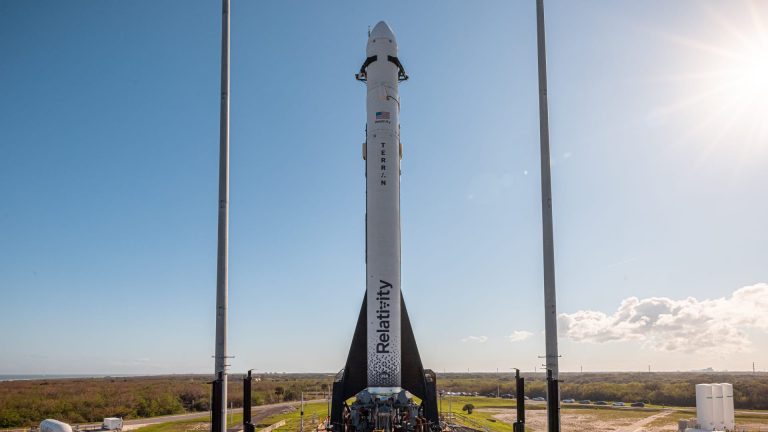
[ad_1]
[The company’s livestream is slated to begin at noon ET. Please refresh the page if you do not see the video player above.]
3D-printing specialist Relativity Space is attempting its first rocket launch on Wednesday, a mission that marks the most significant test yet of the company’s ambitious manufacturing approach.
The company’s Terran 1 rocket is launching from LC-16, a launchpad at the U.S. Space Force’s facility in Cape Canaveral, Florida. Relativity has a window between 1 p.m. and 4 p.m. ET to launch the mission, or postpone to a later date. The mission is called “Good Luck, Have Fun,” and aims to successfully reach orbit.
The company’s Terran 1 rocket stands on its launchpad at LC-16 in Cape Canaveral, Florida ahead of the inaugural launch attempt.
Trevor Mahlmann / Relativity Space
While many space companies utilize 3D-printing, also known as additive manufacturing, Relativity has effectively gone all-in on the approach. The company believes its approach will make building orbital-class rockets much faster than traditional methods, requiring thousands less parts and enabling changes to be made via software. The Long Beach, California-based venture aims to create rockets from raw materials in as little as 60 days.
Terran 1 stands 110 feet high, with nine engines powering the lower first stage, and one engine powering the upper second stage. Its Aeon engines are 3D-printed, with the rocket using liquid oxygen and liquid natural gas as its two fuel types. The company says that 85% of this first Terran 1 rocket was 3D-printed.
Relativity prices Terran 1 at $12 million per launch. It’s designed to carry about 1,250 kilograms to low Earth orbit. That puts Terran 1 in the “medium lift” section of the U.S. launch market, between Rocket Lab’s Electron and SpaceX’s Falcon 9 in both price and capability.
Wednesday’s debut for Terran 1 is not carrying a payload or satellite inside the rocket. The company emphasized the launch represents a prototype.
In a series of tweets before the mission, cofounder and CEO Tim Ellis shared his expectations for the mission: He noted that reaching a milestone of maximum aerodynamic pressure about 80 seconds after liftoff would be a “key inflection” point for proving the company’s technology.
A timelapse of Relativity’s Stargate 3D printer building a rocket fuel tank.
Relativity Space | gif by @thesheetztweetz
[ad_2]
Source link